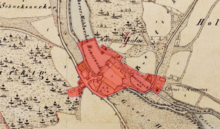Hammer goose

Hammergänlas is a lost place in today's Grafenwöhr military training area . It was destroyed in 1936 when the military training area was expanded and is now a ground monument .
location
The hamlet was 423 m above sea level. NN on the Frankenohe, a tributary of the Vils , which fed several ponds there, including the Hammerweiher.
history
The name Gänlas is derived from the personal name Gnendlein , a diminutive for Gnanno . An iron hammer was soon set up in the initially small settlement .
Hammer and Castle Hammergänlas
In the Upper Palatinate hammer cleaning of January 7, 1387, “Chvnrad Pflawn with the hamer zu den Gnienleins” is mentioned among the 64 signatories.
Hermann Schmückner († around 1465) from the Auerbach Hammer family of the same name , was then the operator of Hammergänlas. 1488 had the Schienhammer "Gnenleins" a Peter Heber. In 1542 Lorenz Heber is named as the hammer owner. The jacks also operated the hammer during the Thirty Years' War . In 1625 Hans Balthasar Heber left his possessions in Gänlas and Rothenbruck and moved to Nuremberg because he did not want to convert to the Catholic faith again. His retarded wife, daughter of the innkeeper Held, ran the hammer mill until her death. In 1652 the former imperial Rittmeister Hans Dietrich Wolf is named as the owner of the Gänlas hammer. He sold the property soon to Vilsecker citizen Johann Andrä Merz of Attracted Reuth and Hellziechen who operated the plant from 1654 to 1669. In 1669 he gave the hammer to his daughter, she married Conrad Schreyer von Blumenthal, this family had owned the hammer for 92 years.
In 1722 the farmer Georg Graf (1675–1742) had already bought Altneuhaus and in 1740 Altenweiher . His son Georg received the hammer Heringnohe as an inheritance , the other son Johann Georg received the Hammergut Altneuhaus. In 1757 this Johann Georg Graf from Oberweißbach bought the Hammergänlas estate from Maximilian von Blumenthal, who had come to the Gant . On December 2, 1757 Johann Georg Graf (1718–1802) was elected by the Elector Maximilian III. Joseph raised to the nobility because "as a simple farmer with a lot of diligence and intelligence he could acquire two country estates"; after that he called himself Graf von Grafenstein. Johann Georg von Grafenstein was a district judge in Parkstein . His son Johann Georg (1742–1823) succeeded his father in Parkstein in January 1767, while the other son Simon Andrä became district judge in Auerbach in 1784. The Grafenbauernhof in Oberweißbach still exists today; it has been owned by the Trummer family for around 200 years.
Hammer Gänlas stopped iron production in 1861.
Hammergänlas Castle Brewery
The "Schloß-Bräu" zu Gänlas was founded in 1724 by the Schreyer von Blumenthal family. This family held it until 1757. In 1812, the Hofmark Hammergänlas with lower jurisdiction is described as having a brewery with a cellar and apartment, a malt house and a tavern alongside other buildings. In 1936, the entire property of the von Grafenstein family was removed from the state. Dr. Adolf Rupert Gustav von Grafenstein used the transfer fee to buy the Löwenbrauerei in Grafenwöhr, which no longer exists today. The estate in Obersteinbach in Markt Taschendorf , which is still managed today by a member of the von Grafenstein family, was also acquired.
From the formation of the community
Due to the municipal edict in Bavaria, Hammergänlas became part of the newly created municipality of Nunkas in 1818 . In 1925 the place had 44 inhabitants in 9 residential buildings.
During the expansion of the Grafenwöhr military training area in accordance with the decree of the Reichswehr Ministry of February 28, 1936, the place was relocated and destroyed.
today
Today Hammergänlas and Nunkas deserted villages in the Grafenwoehr Training Area. The area at the entrance to the current shooting range 201 is overgrown with trees and bushes and is partially forested.
Hammergänlas is described as a ground monument of the municipality of Grafenwöhr under the file number D-3-6336-0024, as "underground medieval and early modern findings in the deserted 'Hammergänlas', including the traces of an iron hammer with an associated hammer lock ".
Web links
Individual evidence
- ↑ The treasure from the count's farm from October 15, 2019, accessed on August 21, 2020
- ↑ Culture and Military Museum Grafenwöhr: Legendary - the Grafenwöhr Lion Brewery from August 4th, 2020, accessed on August 21st, 2020
- ^ Family von Grafenstein - Journey into the past . Onetz from June 22, 2016, accessed on August 21, 2020
- ^ Locations directory for the Free State of Bavaria, based on the 1925 census
- ↑ Bayerischer Landesverein für Familienkunde eV: Desolations in the Upper Palatinate and neighboring Bohemia , accessed on August 21, 2020
Coordinates: 49 ° 40 ′ 59.8 " N , 11 ° 44 ′ 42.4" E
